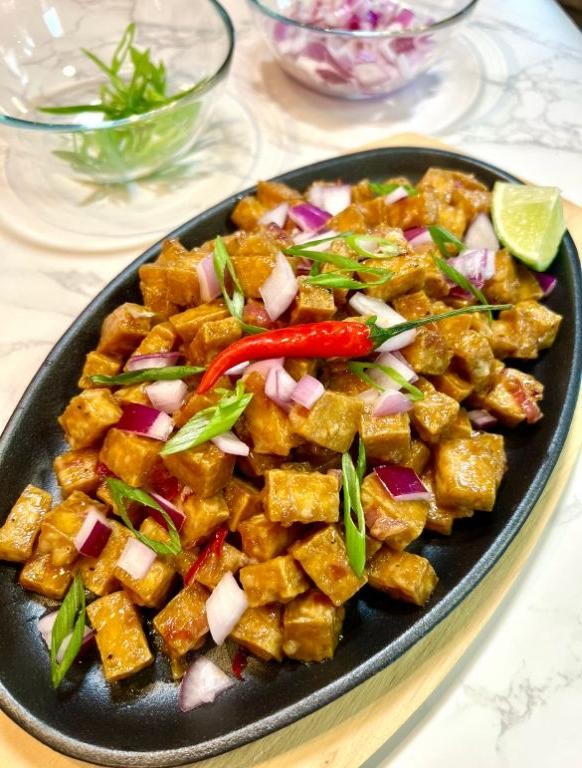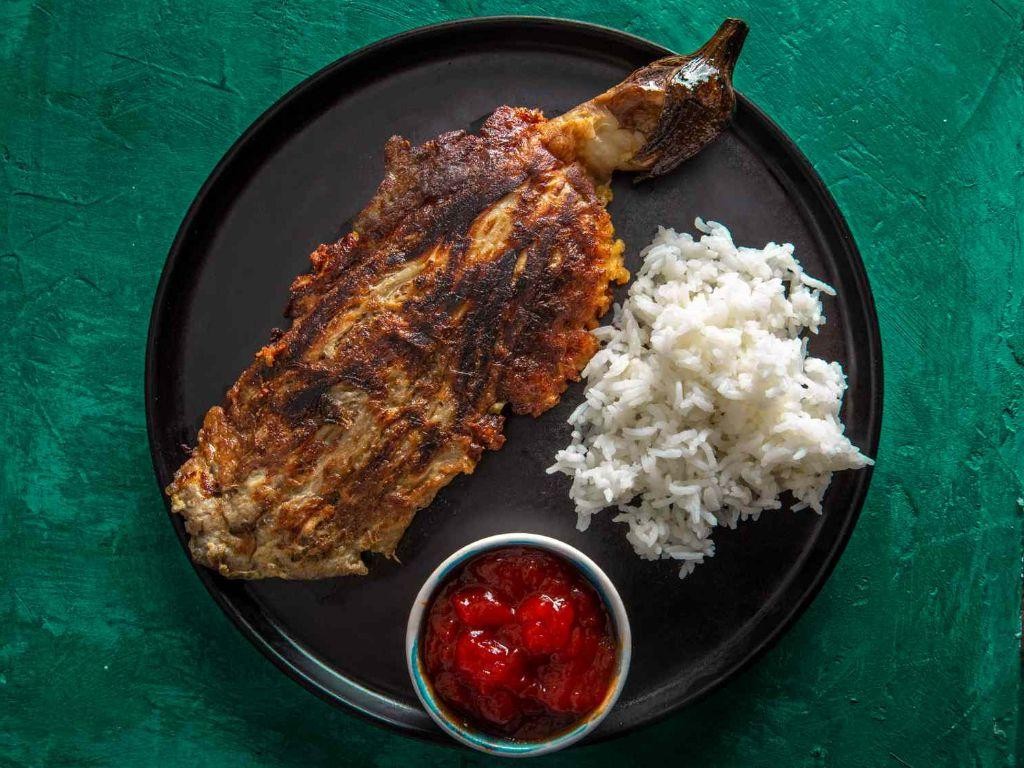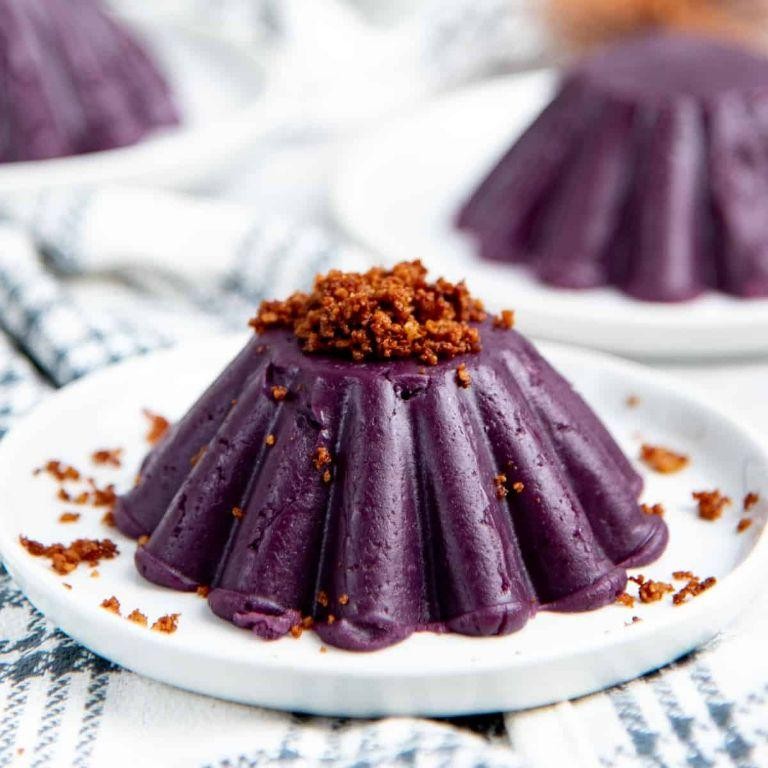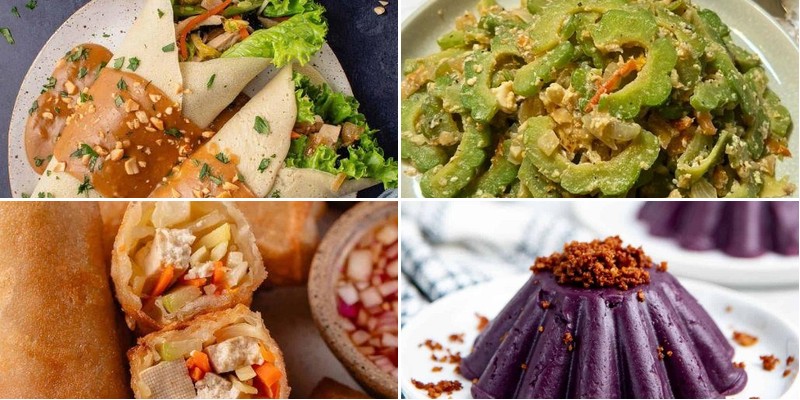Welcome to the vibrant world of Filipino vegetarian cuisine! Whether you’re craving quick weeknight dinners, comforting classics, or exploring new flavors, these 25 meat-free dishes bring the tropical tastes of the Philippines right to your kitchen. From savory stews to fresh salads, get ready to discover delicious plant-based versions of traditional favorites that will delight your taste buds and inspire your next meal.
Adobo Sa Gulay (Vegetarian Vegetable Adobo)

Aren’t you tired of the same old vegetable dishes? You need something with bold flavor that still feels healthy and comforting. This Filipino-inspired vegetable adobo brings all the savory goodness without any meat.
2
servings25
minutes45
minutesIngredients
– 2 tablespoons rich extra virgin olive oil
– 1 large yellow onion, thinly sliced into half-moons
– 4 plump garlic cloves, finely minced
– 1 pound firm tofu, pressed and cubed into 1-inch pieces
– 1 large eggplant, cut into 1-inch cubes
– 2 cups green beans, trimmed and cut into 2-inch lengths
– ½ cup premium soy sauce
– ⅓ cup apple cider vinegar
– 1 cup vegetable broth
– 2 dried bay leaves
– 1 teaspoon freshly cracked black pepper
– 1 tablespoon organic brown sugar
Instructions
1. Heat 2 tablespoons of rich extra virgin olive oil in a large Dutch oven over medium heat until shimmering.
2. Add 1 large yellow onion, thinly sliced into half-moons, and cook for 4-5 minutes until translucent and fragrant.
3. Stir in 4 plump garlic cloves, finely minced, and cook for 1 minute until golden and aromatic.
4. Add 1 pound firm tofu, pressed and cubed into 1-inch pieces, and cook for 6-8 minutes, turning occasionally until golden brown on all sides.
5. Tip: Press your tofu for at least 30 minutes beforehand—this helps it absorb the sauce better and get that perfect crispy texture.
6. Mix in 1 large eggplant, cut into 1-inch cubes, and cook for 5 minutes until slightly softened.
7. Add 2 cups green beans, trimmed and cut into 2-inch lengths, and cook for 3 minutes until bright green.
8. Pour in ½ cup premium soy sauce, ⅓ cup apple cider vinegar, and 1 cup vegetable broth, scraping any browned bits from the bottom of the pot.
9. Drop in 2 dried bay leaves and sprinkle 1 teaspoon freshly cracked black pepper and 1 tablespoon organic brown sugar into the mixture.
10. Tip: Don’t stir the vinegar in too vigorously at first—letting it sit for a moment helps preserve its bright acidity.
11. Bring the mixture to a gentle boil, then immediately reduce heat to low and cover the pot.
12. Simmer for 20-25 minutes until the eggplant is tender but not mushy and the green beans are crisp-tender.
13. Tip: Keep the lid slightly ajar to allow some steam to escape, which helps concentrate the flavors without overcooking the vegetables.
14. Remove the bay leaves before serving.
Unbelievably satisfying, this dish balances tender eggplant and crisp green beans with that signature adobo tang. The tofu soaks up all the savory-sour sauce beautifully, making each bite more complex than the last. Try serving it over jasmine rice or stuffing it into warm tortillas for a fun fusion twist.
Tofu Sisig

Vegan comfort food just got a major upgrade with this sizzling tofu sisig. You’re going to love how the crispy tofu soaks up all those bold Filipino flavors, creating a dish that’s perfect for weeknight dinners or game day gatherings. It’s the kind of meal that makes you forget you’re eating plant-based.
2
servings40
minutes16
minutesIngredients
– 1 block extra-firm tofu, pressed and crumbled
– 2 tablespoons neutral avocado oil
– 1 large yellow onion, finely diced
– 4 cloves fresh garlic, minced
– 2 Thai chilies, thinly sliced
– 3 tablespoons soy sauce
– 2 tablespoons calamansi juice (or fresh lime juice)
– 1 tablespoon vegan mayonnaise
– 1 teaspoon freshly ground black pepper
– 2 green onions, thinly sliced
– 1 red bell pepper, finely chopped
Instructions
1. Press one block of extra-firm tofu for 30 minutes using a tofu press or heavy pan to remove excess moisture.
2. Crumble the pressed tofu into small, uneven pieces using your hands for better texture absorption.
3. Heat 2 tablespoons of neutral avocado oil in a large cast iron skillet over medium-high heat until shimmering.
4. Add the crumbled tofu and cook for 8-10 minutes, stirring occasionally, until golden brown and crispy around the edges.
5. Push tofu to one side of the skillet and add the finely diced yellow onion, cooking for 3 minutes until translucent.
6. Add the minced fresh garlic and thinly sliced Thai chilies, cooking for 1 minute until fragrant.
7. Combine all ingredients in the skillet and add 3 tablespoons of soy sauce, stirring to coat evenly.
8. Pour in 2 tablespoons of calamansi juice and cook for 2 minutes, allowing the liquid to reduce slightly.
9. Remove skillet from heat and stir in 1 tablespoon of vegan mayonnaise until creamy and well-incorporated.
10. Season with 1 teaspoon of freshly ground black pepper and mix thoroughly.
11. Garnish with thinly sliced green onions and finely chopped red bell pepper for fresh crunch and color.
You’ll notice the tofu develops this incredible crispy-chewy texture that holds up beautifully against the tangy, spicy sauce. Serve it sizzling hot straight from the skillet with steamed rice, or get creative by stuffing it into warm tortillas for Filipino-inspired tacos that’ll become your new favorite weeknight hack.
Laing (Taro Leaves in Coconut Milk)

Tired of the same old dinner rotation? Let’s shake things up with laing, a Filipino comfort food that transforms humble taro leaves into something magical. You’re going to love how the creamy coconut milk balances the earthy greens in this surprisingly simple dish.
2
servings15
minutes85
minutesIngredients
– 8 ounces dried taro leaves
– 2 tablespoons rich coconut oil
– 1 large yellow onion, finely diced
– 4 cloves fresh garlic, minced
– 1 thumb-sized piece of ginger, freshly grated
– 2 cups rich coconut milk
– 1 cup light coconut cream
– 2 tablespoons fish sauce
– 2 fresh red chilies, thinly sliced
– 1 cup pork belly, cut into small cubes
Instructions
1. Heat 2 tablespoons of rich coconut oil in a large Dutch oven over medium heat until shimmering.
2. Add 1 cup of cubed pork belly and cook for 8-10 minutes until golden brown and crispy, stirring occasionally.
3. Add the finely diced yellow onion and cook for 4-5 minutes until translucent and fragrant.
4. Stir in the minced garlic and freshly grated ginger, cooking for 1 minute until aromatic.
5. Pour in 2 cups of rich coconut milk and 1 cup of light coconut cream, scraping any browned bits from the bottom of the pot.
6. Add 2 tablespoons of fish sauce and bring the mixture to a gentle simmer.
7. Carefully add 8 ounces of dried taro leaves, submerging them completely in the coconut mixture.
8. Reduce heat to low, cover, and simmer for 45 minutes, stirring every 15 minutes to prevent sticking.
9. Stir in the thinly sliced red chilies during the last 10 minutes of cooking.
10. Remove the lid and continue cooking for another 15 minutes until the sauce has thickened and the leaves are tender.
A perfect laing should have leaves that melt in your mouth while the sauce clings beautifully to each strand. The pork belly adds wonderful texture contrast to the creamy coconut base. Try serving it over steamed jasmine rice or with crusty bread to soak up every last drop of that incredible sauce.
Pancit Canton with Tofu and Vegetables

Unbelievably satisfying and packed with flavor, this Pancit Canton with Tofu and Vegetables is your new go-to weeknight dinner. You’ll love how the chewy noodles soak up all that savory goodness while the crispy tofu adds the perfect protein punch. It’s one of those dishes that feels fancy but comes together in no time.
5
servings15
minutes21
minutesIngredients
- 8 ounces dried pancit canton noodles
- 14 ounces firm tofu, pressed and cubed
- 2 tablespoons toasted sesame oil
- 3 cloves garlic, minced
- 1 medium yellow onion, thinly sliced
- 2 medium carrots, julienned
- 1 cup green cabbage, shredded
- 1 cup snow peas, trimmed
- 3 tablespoons soy sauce
- 1 tablespoon oyster sauce
- 1 teaspoon freshly ground black pepper
- 2 cups vegetable broth
- 2 green onions, thinly sliced
- 1 lime, cut into wedges
Instructions
- Bring a large pot of water to a rolling boil over high heat.
- Add the dried pancit canton noodles and cook for exactly 3 minutes, stirring occasionally to prevent sticking.
- Drain the noodles immediately in a colander and rinse with cold water to stop the cooking process. Tip: Rinsing prevents the noodles from becoming mushy later.
- Heat 1 tablespoon of toasted sesame oil in a large wok or skillet over medium-high heat until shimmering.
- Add the pressed and cubed tofu in a single layer and cook for 4-5 minutes per side until golden brown and crispy.
- Transfer the crispy tofu to a plate lined with paper towels to drain excess oil.
- Add the remaining 1 tablespoon of toasted sesame oil to the same wok over medium heat.
- Sauté the minced garlic and thinly sliced yellow onion for 2 minutes until fragrant and translucent.
- Add the julienned carrots and shredded green cabbage, stirring constantly for 3 minutes until slightly softened.
- Incorporate the trimmed snow peas and cook for another 2 minutes until bright green but still crisp.
- Pour in the vegetable broth, soy sauce, and oyster sauce, bringing the mixture to a gentle simmer.
- Add the cooked pancit canton noodles to the wok, tossing gently to coat evenly with the sauce and vegetables.
- Cook for 4-5 minutes, stirring frequently, until most of the liquid has been absorbed by the noodles. Tip: The noodles should be tender but still have a slight chew.
- Sprinkle with freshly ground black pepper and return the crispy tofu to the wok, gently folding to combine.
- Remove from heat and let rest for 2 minutes before serving. Tip: Resting allows the flavors to meld together perfectly.
Delightfully textured with chewy noodles, crispy tofu, and crunchy vegetables, this dish offers a wonderful balance in every bite. The savory sauce clings beautifully to each component, while a squeeze of fresh lime brightens everything up. Serve it family-style with extra lime wedges and sliced green onions scattered over the top for a vibrant presentation that’s as impressive as it is delicious.
Vegetarian Kare-Kare with Peanut Sauce

A comforting Filipino classic just got a plant-based makeover that’ll have everyone asking for seconds. You’re going to love how the rich peanut sauce coats every vegetable in this hearty stew—it’s the perfect cozy meal for chilly evenings.
2
servings20
minutes47
minutesIngredients
– 2 tablespoons golden toasted sesame oil
– 1 large yellow onion, thinly sliced into half-moons
– 4 cloves fresh garlic, finely minced
– 1 pound mixed Asian eggplants, cut into 2-inch chunks
– 2 cups fresh green beans, trimmed and cut into 2-inch pieces
– 1 large banana blossom, thinly sliced and soaked in water
– 1 cup creamy smooth peanut butter
– 4 cups rich vegetable broth
– 2 tablespoons dark soy sauce
– 1 teaspoon fine sea salt
– 1/2 teaspoon freshly cracked black pepper
– 2 tablespoons cornstarch mixed with 1/4 cup cold water
– 1/4 cup crushed roasted peanuts for garnish
Instructions
1. Heat the golden toasted sesame oil in a large Dutch oven over medium heat until shimmering.
2. Add the thinly sliced yellow onion and cook for 5 minutes, stirring occasionally, until translucent and fragrant.
3. Stir in the finely minced fresh garlic and cook for 1 minute until golden and aromatic.
4. Add the Asian eggplant chunks and cook for 8 minutes, stirring occasionally, until slightly softened.
5. Tip: Don’t overcrowd the pan—cook in batches if needed for even browning.
6. Pour in the rich vegetable broth and bring to a gentle boil.
7. Reduce heat to low and simmer uncovered for 15 minutes until eggplant is tender.
8. Add the trimmed green beans and soaked banana blossom slices to the pot.
9. Cook for another 10 minutes until vegetables are crisp-tender.
10. Whisk in the creamy smooth peanut butter until fully incorporated and sauce is smooth.
11. Tip: If peanut butter is thick, thin it with a ladle of hot broth before adding to the pot.
12. Stir in the dark soy sauce, fine sea salt, and freshly cracked black pepper.
13. Simmer for 5 minutes to allow flavors to meld together.
14. Gradually add the cornstarch slurry while stirring constantly.
15. Cook for 3-4 minutes until sauce thickens to coat the back of a spoon.
16. Tip: For extra thickness, let the stew rest off heat for 10 minutes before serving.
17. Ladle into bowls and garnish generously with crushed roasted peanuts.
Enjoy how the velvety peanut sauce clings to each vegetable, creating layers of nutty richness with every spoonful. The tender eggplant practically melts while the green beans add satisfying crunch—serve it over steaming jasmine rice for the ultimate comfort meal experience.
Inihaw na Talong (Grilled Eggplant)

Zesty grilled eggplant might just become your new favorite summer side dish! This Filipino-inspired Inihaw na Talong brings smoky, creamy eggplant to your table with minimal effort. You’ll love how the charred exterior gives way to that soft, silky interior.
3
servings10
minutes10
minutesIngredients
– 4 medium firm eggplants
– 2 tablespoons rich extra virgin olive oil
– 3 cloves fragrant garlic, minced
– 2 tablespoons tangy soy sauce
– 1 tablespoon fresh-squeezed calamansi or lemon juice
– 1 teaspoon sweet cane sugar
– ½ teaspoon coarsely ground black pepper
– ¼ cup finely chopped fresh green onions
Instructions
1. Preheat your outdoor grill to medium-high heat (400°F) or heat a grill pan over medium-high heat on your stovetop.
2. Pierce each eggplant 4-5 times with a fork to prevent bursting during grilling.
3. Brush all eggplant surfaces lightly with 1 tablespoon of the rich extra virgin olive oil.
4. Place eggplants directly on the grill grates and cook for 8-10 minutes, turning every 2-3 minutes with tongs until the skin is charred and blistered all over.
5. Transfer the grilled eggplants to a cutting board and let them cool for 5 minutes until comfortable to handle.
6. Carefully peel off the charred skin using your fingers, leaving the tender flesh intact.
7. Gently flatten each eggplant with the back of a fork, creating a bed-like shape on your serving plate.
8. In a small bowl, whisk together the remaining 1 tablespoon of rich extra virgin olive oil, minced fragrant garlic, tangy soy sauce, fresh-squeezed calamansi juice, sweet cane sugar, and coarsely ground black pepper.
9. Drizzle the savory sauce evenly over all four flattened eggplants.
10. Sprinkle the finely chopped fresh green onions generously across the top.
Each bite delivers that wonderful contrast between the smoky grilled exterior and the melt-in-your-mouth creamy interior. The tangy garlic sauce soaks into the warm eggplant beautifully, making this perfect alongside grilled meats or as a standout vegetarian main. Try serving it over steaming jasmine rice to soak up every last drop of that delicious sauce!
Munggo Guisado (Mung Bean Stew)

Brimming with cozy comfort, this Filipino mung bean stew is the perfect one-pot meal for chilly evenings. You’ll love how the tender beans soak up all the savory flavors while the spinach adds a fresh pop of green. It’s the kind of dish that makes you feel nourished from the inside out.
2
servings15
minutes79
minutesIngredients
- 1 cup dried mung beans, rinsed and picked over
- 4 cups chicken broth, rich and savory
- 2 tablespoons olive oil, golden and fragrant
- 4 cloves garlic, minced until aromatic
- 1 medium yellow onion, diced into small pieces
- 2 medium tomatoes, chopped with their juicy seeds
- 1/2 pound pork shoulder, cut into bite-sized cubes
- 2 cups fresh spinach leaves, washed and packed
- 1 tablespoon fish sauce, pungent and savory
- 1/2 teaspoon black pepper, freshly ground
Instructions
- Place the rinsed mung beans and chicken broth in a large pot over medium-high heat.
- Bring the mixture to a rolling boil, then reduce heat to maintain a gentle simmer.
- Cover the pot and cook for 45 minutes until the beans are tender but still hold their shape.
- While the beans cook, heat olive oil in a separate skillet over medium heat until it shimmers.
- Add the pork cubes and cook for 6-8 minutes until browned on all sides.
- Transfer the browned pork to a plate, leaving the rendered fat in the skillet.
- Add the diced onion to the hot skillet and cook for 3-4 minutes until translucent.
- Stir in the minced garlic and cook for 1 minute until fragrant but not browned.
- Add the chopped tomatoes and cook for 5 minutes until they break down into a saucy consistency.
- Tip: Crush the tomatoes with your spoon to help release their natural juices faster.
- Return the cooked pork to the skillet and stir to combine with the tomato mixture.
- Transfer the pork and vegetable mixture to the pot with the cooked mung beans.
- Stir in the fish sauce and black pepper until well incorporated.
- Simmer the stew uncovered for 15 minutes to allow the flavors to meld together.
- Tip: The stew should thicken slightly but still have a soupy consistency.
- Turn off the heat and stir in the fresh spinach until it wilts completely.
- Tip: Don’t overcook the spinach – it should remain vibrant green and tender.
- Let the stew rest for 5 minutes before serving to allow the flavors to settle.
Creamy mung beans create the most satisfying texture against the tender pork pieces. The subtle earthiness of the beans balances beautifully with the tangy tomatoes and savory fish sauce. Try serving it over steamed rice with a squeeze of calamansi or lime for that perfect bright finish.
Pinakbet (Vegetable Stew with Fermented Fish Substitute)

Zesty and vibrant, this Filipino vegetable stew brings the flavors of the Philippines right to your kitchen. You’ll love how the savory fermented fish substitute melds with all those fresh veggies. It’s a comforting one-pot wonder that feels both exotic and totally approachable.
2
servings20
minutes61
minutesIngredients
– 2 tablespoons rich coconut oil
– 1 medium yellow onion, thinly sliced
– 4 cloves garlic, finely minced
– 2 tablespoons savory fermented fish substitute (bagoong)
– 1 pound pork belly, cut into 1-inch cubes
– 4 cups rich chicken broth
– 2 medium tomatoes, chopped
– 1 large eggplant, cut into 2-inch chunks
– 1 cup sliced okra, fresh and tender
– 1 bitter melon, seeded and sliced
– 2 cups kabocha squash, peeled and cubed
– 1 cup long beans, cut into 2-inch pieces
– Freshly ground black pepper
Instructions
1. Heat 2 tablespoons of rich coconut oil in a large pot over medium heat until shimmering.
2. Add 1 medium yellow onion, thinly sliced, and cook for 3 minutes until translucent.
3. Stir in 4 cloves of finely minced garlic and cook for 1 minute until fragrant.
4. Add 2 tablespoons of savory fermented fish substitute and cook for 2 minutes, stirring constantly to develop depth of flavor.
5. Tip: Toasting the fermented fish substitute enhances its umami character without making it too salty.
6. Add 1 pound of pork belly, cut into 1-inch cubes, and cook for 8 minutes until lightly browned on all sides.
7. Pour in 4 cups of rich chicken broth and 2 medium chopped tomatoes, then bring to a boil.
8. Reduce heat to low, cover, and simmer for 25 minutes until pork is tender.
9. Add 2 cups of kabocha squash, peeled and cubed, and simmer uncovered for 10 minutes until slightly softened.
10. Tip: Adding squash first ensures it cooks through without turning mushy from extended boiling.
11. Stir in 1 large eggplant cut into 2-inch chunks, 1 cup of fresh tender okra, 1 bitter melon seeded and sliced, and 1 cup of long beans cut into 2-inch pieces.
12. Simmer uncovered for 15 minutes until all vegetables are tender but still hold their shape.
13. Season with freshly ground black pepper to taste.
14. Tip: Avoid stirring too vigorously to keep the vegetables intact and visually appealing.
15. Remove from heat and let stand for 5 minutes before serving.
Delightfully textured, this stew offers tender-crisp vegetables swimming in a savory, slightly funky broth. The bitter melon provides a pleasant contrast to the sweet squash, while the pork belly adds richness to every spoonful. Serve it over steamed jasmine rice or with a side of crispy fried fish for a truly authentic Filipino meal experience.
Tortang Talong (Eggplant Omelet)

A perfectly charred eggplant might not be your usual breakfast choice, but trust me—this Filipino classic will change your morning routine. You get smoky, tender eggplant wrapped in a golden egg blanket that’s both comforting and surprisingly easy to make. It’s the kind of dish that feels fancy but comes together in minutes.
2
portions15
minutes20
minutesIngredients
– 2 medium-sized eggplants with glossy, deep purple skins
– 4 large farm-fresh eggs
– 2 tablespoons rich extra virgin olive oil
– 3 cloves aromatic garlic, minced
– 1 small sweet yellow onion, finely diced
– 1 teaspoon fine sea salt
– ½ teaspoon freshly ground black pepper
Instructions
1. Preheat your oven broiler to high (500°F) and line a baking sheet with aluminum foil.
2. Place both whole eggplants directly on the prepared baking sheet and broil for 8-10 minutes, turning once halfway, until the skins are charred and blistered.
3. Transfer the hot eggplants to a bowl and cover tightly with plastic wrap for 5 minutes—this steam-loosens the skins for easy peeling.
4. Carefully peel away the charred skins while keeping the stems intact and the flesh in one piece.
5. Gently flatten each eggplant using the back of a fork, creating a paddle-shaped base about ½-inch thick.
6. Crack all 4 eggs into a shallow bowl and whisk vigorously for 30 seconds until fully blended and slightly frothy.
7. Stir in the minced garlic, diced onion, sea salt, and black pepper until evenly distributed.
8. Heat 1 tablespoon of olive oil in a large nonstick skillet over medium heat (350°F) until shimmering.
9. Dip one flattened eggplant into the egg mixture, ensuring it’s fully coated on both sides.
10. Carefully place the coated eggplant in the hot skillet and cook for 3-4 minutes until the bottom is golden brown and crisp.
11. Flip using a wide spatula and cook for another 3 minutes until the second side is equally golden.
12. Repeat with the remaining eggplant, adding the second tablespoon of oil to the skillet between batches. Seriously, you’ll love how the edges get delightfully crispy while the eggplant stays meltingly tender inside. Try serving it with steamed jasmine rice and a side of spicy banana ketchup for an authentic Filipino breakfast experience—the creamy texture against the savory egg coating is pure comfort.
Filipino-Style Vegetable Curry

Sometimes you just crave something that’s both comforting and packed with flavor, and this Filipino-style vegetable curry hits all the right notes. It’s a vibrant, coconut-based dish that comes together in one pot, making your weeknight dinner both exciting and effortless. You’ll love how the spices meld with fresh veggies for a truly satisfying meal.
4
servings20
minutes45
minutesIngredients
– 2 tablespoons fragrant coconut oil
– 1 large yellow onion, thinly sliced
– 4 cloves garlic, finely minced
– 1 thumb-sized piece of fresh ginger, peeled and grated
– 2 tablespoons golden curry powder
– 1 (13.5-ounce) can rich, creamy coconut milk
– 2 cups homemade or low-sodium vegetable broth
– 2 medium carrots, peeled and cut into ½-inch coins
– 1 large potato, peeled and diced into ¾-inch cubes
– 1 small eggplant, chopped into 1-inch pieces
– 1 red bell pepper, seeded and sliced into thin strips
– 1 cup fresh green beans, trimmed and cut into 1-inch lengths
– 1 tablespoon tangy fish sauce (or soy sauce for a vegan option)
– 1 teaspoon granulated sugar
– ½ teaspoon fine sea salt
– ¼ teaspoon freshly cracked black pepper
– 2 tablespoons fresh cilantro, roughly chopped for garnish
Instructions
1. Heat 2 tablespoons of fragrant coconut oil in a large, heavy-bottomed pot or Dutch oven over medium heat until it shimmers.
2. Add 1 large thinly sliced yellow onion and sauté, stirring occasionally, for about 5 minutes until softened and translucent.
3. Stir in 4 cloves of finely minced garlic and 1 thumb-sized piece of grated fresh ginger, cooking for 1 minute until fragrant.
4. Sprinkle 2 tablespoons of golden curry powder into the pot and toast for 30 seconds, stirring constantly to prevent burning.
5. Pour in 1 can of rich, creamy coconut milk and 2 cups of vegetable broth, scraping the bottom of the pot to lift any browned bits.
6. Add 2 medium carrots cut into ½-inch coins and 1 large potato diced into ¾-inch cubes, then bring the mixture to a gentle boil.
7. Reduce the heat to low, cover the pot, and simmer for 10 minutes to partially soften the root vegetables.
8. Stir in 1 small eggplant chopped into 1-inch pieces, 1 red bell pepper sliced into thin strips, and 1 cup of fresh green beans cut into 1-inch lengths.
9. Season with 1 tablespoon of tangy fish sauce, 1 teaspoon of granulated sugar, ½ teaspoon of fine sea salt, and ¼ teaspoon of freshly cracked black pepper.
10. Cover the pot again and simmer for 15–20 minutes, or until all vegetables are tender but not mushy.
11. Turn off the heat and let the curry rest for 5 minutes to allow the flavors to meld together.
12. Garnish with 2 tablespoons of roughly chopped fresh cilantro just before serving.
Generously ladle this curry over steamed jasmine rice to soak up every bit of the creamy, spiced sauce. The potatoes and carrots become wonderfully tender, while the eggplant and bell peppers keep a slight bite for contrast. For a fun twist, serve it in hollowed-out bell pepper bowls or with a side of crispy plantain chips to add crunch.
Ginisang Ampalaya (Sauteed Bitter Melon) with Tofu

Just when you think you’ve tried all the veggie stir-fries, this Filipino classic comes along to surprise your taste buds. Ginisang Ampalaya brings together bitter melon’s unique flavor with protein-packed tofu in a dish that’s both healthy and satisfying. It’s that perfect quick dinner when you want something flavorful but don’t feel like spending hours in the kitchen.
3
servings20
minutes22
minutesIngredients
– 2 medium bitter melons, sliced into thin half-moons
– 14 oz firm tofu, pressed and cubed
– 2 tbsp rich extra virgin olive oil
– 1 medium yellow onion, thinly sliced
– 3 cloves fresh garlic, minced
– 2 large ripe tomatoes, chopped
– 2 tbsp premium soy sauce
– 1 tsp freshly cracked black pepper
– 1 cup water
Instructions
1. Cut each bitter melon in half lengthwise and scoop out the white pith and seeds with a spoon.
2. Slice the bitter melon into thin half-moons about ¼-inch thick.
3. Place the sliced bitter melon in a bowl and sprinkle with 1 teaspoon of salt, then massage gently and let sit for 10 minutes to reduce bitterness.
4. Rinse the salted bitter melon thoroughly under cold running water and squeeze out excess moisture.
5. Heat 2 tablespoons of rich extra virgin olive oil in a large skillet over medium-high heat until shimmering.
6. Add 14 oz of pressed and cubed firm tofu and cook for 4-5 minutes, turning occasionally, until golden brown on all sides.
7. Remove the tofu from the skillet and set aside on a plate.
8. Add 1 thinly sliced medium yellow onion to the same skillet and sauté for 3 minutes until translucent.
9. Stir in 3 minced cloves of fresh garlic and cook for 1 minute until fragrant.
10. Add 2 chopped large ripe tomatoes and cook for 3 minutes until they begin to break down.
11. Return the prepared bitter melon to the skillet and stir to combine with the aromatics.
12. Pour in 1 cup of water and bring to a simmer.
13. Cover the skillet and cook for 8 minutes until the bitter melon is tender but still slightly crisp.
14. Add back the golden tofu cubes to the skillet.
15. Drizzle 2 tablespoons of premium soy sauce over the mixture.
16. Sprinkle 1 teaspoon of freshly cracked black pepper throughout.
17. Stir everything together and cook uncovered for 2 more minutes to let flavors meld.
Every bite gives you that wonderful contrast between the slightly crisp bitter melon and tender tofu cubes. The bitterness mellows beautifully with the savory soy sauce and sweet tomatoes. Try serving it over steaming jasmine rice or alongside grilled fish for a complete Filipino-inspired meal that’ll have everyone asking for seconds.
Vegetarian Sinigang (Sour Soup with Vegetables)

Haven’t you been craving something that’s both comforting and packed with bright, tangy flavor? This Filipino-inspired vegetarian sinigang is exactly what you need on a chilly day. It’s that perfect balance of sour broth and tender vegetables that’ll warm you right up.
4
servings20
minutes31
minutesIngredients
– 1 large yellow onion, thinly sliced
– 3 cloves garlic, minced
– 2 medium ripe tomatoes, chopped
– 8 cups vegetable broth
– 2 packets tamarind soup mix
– 1 pound baby bok choy, leaves separated
– 1 large daikon radish, peeled and sliced into half-moons
– 2 medium potatoes, peeled and cubed
– 1 cup fresh green beans, trimmed and cut into 2-inch pieces
– 1 tablespoon neutral cooking oil
– 1 teaspoon fine sea salt
– Freshly cracked black pepper
Instructions
1. Heat 1 tablespoon of neutral cooking oil in a large pot over medium heat until shimmering.
2. Add the thinly sliced yellow onion and cook for 3 minutes until translucent.
3. Stir in the minced garlic and cook for 1 minute until fragrant.
4. Add the chopped tomatoes and cook for 4 minutes until they begin to break down.
5. Pour in 8 cups of vegetable broth and bring to a gentle boil.
6. Stir in 2 packets of tamarind soup mix until fully dissolved.
7. Add the cubed potatoes and sliced daikon radish, then reduce heat to maintain a steady simmer.
8. Cover and cook for 15 minutes until the potatoes are fork-tender.
9. Add the trimmed green beans and cook uncovered for 5 minutes until crisp-tender.
10. Stir in the baby bok choy leaves and cook for 2 minutes until just wilted.
11. Season with 1 teaspoon of fine sea salt and freshly cracked black pepper.
12. Remove from heat and let stand for 5 minutes before serving.
Perfect for when you want that satisfying sour punch without the meat. The broth is tangy and clear, while the vegetables maintain their distinct textures—creamy potatoes against crisp beans and tender bok choy. Try serving it over steamed jasmine rice or with a squeeze of calamansi for extra brightness.
Filipino-Style Vegetable Spring Rolls

Sometimes you just need that perfect crispy snack that’s actually packed with veggies. These Filipino-style spring rolls are surprisingly simple to make at home and deliver that satisfying crunch with every bite.
18
rolls25
minutes24
minutesIngredients
– 1 package of thin spring roll wrappers
– 2 cups of finely shredded green cabbage
– 1 cup of julienned sweet carrots
– 1 cup of fresh bean sprouts
– ½ cup of finely chopped yellow onion
– 3 cloves of minced garlic
– 2 tablespoons of rich soy sauce
– 1 teaspoon of freshly ground black pepper
– 4 cups of vegetable oil for frying
– 1 egg, beaten for sealing
Instructions
1. Place your spring roll wrapper on a clean, dry surface with one corner pointing toward you.
2. Arrange 2 tablespoons of the shredded green cabbage in a horizontal line across the center of the wrapper.
3. Top the cabbage with 1 tablespoon of julienned sweet carrots.
4. Add 1 tablespoon of fresh bean sprouts over the carrots.
5. Sprinkle 1 teaspoon of finely chopped yellow onion over the vegetables.
6. Scatter ¼ teaspoon of minced garlic across the vegetable mixture.
7. Drizzle ½ teaspoon of rich soy sauce over the filling.
8. Season with a pinch of freshly ground black pepper.
9. Fold the bottom corner of the wrapper up over the filling, tucking it tightly.
10. Fold the left and right corners inward toward the center.
11. Brush the top corner with beaten egg using a pastry brush.
12. Roll the spring roll upward firmly to seal completely.
13. Repeat steps 1-12 until all filling is used.
14. Heat 4 cups of vegetable oil in a deep pot to 350°F, checking with a deep-fry thermometer.
15. Carefully place 3-4 spring rolls into the hot oil using tongs.
16. Fry for 3-4 minutes until golden brown and crispy, turning occasionally.
17. Remove spring rolls from oil and drain on a wire rack set over a baking sheet.
18. Let cool for 2 minutes before serving.
Ultimate crunch meets fresh veggie goodness in every bite of these golden rolls. The crisp wrapper gives way to tender, savory vegetables that stay surprisingly vibrant even after frying. Try serving them with a sweet chili dipping sauce or alongside a fresh green salad for the perfect balance.
Bicol Express with Tempeh

Ever find yourself craving something spicy, creamy, and deeply satisfying? Enter this plant-based twist on a Filipino classic—Bicol Express with tempeh. You get all that fiery coconut goodness without the meat, and it’s surprisingly simple to whip up on a busy weeknight.
2
servings15
minutes25
minutesIngredients
- 8 ounces firm tempeh, crumbled into coarse bits
- 1 tablespoon rich coconut oil
- 1 large yellow onion, finely diced
- 4 cloves fresh garlic, minced
- 1 thumb-sized piece of ginger, freshly grated
- 2–3 Thai bird’s eye chilies, thinly sliced (adjust for heat)
- 1 tablespoon savory shrimp paste
- 1 (13.5-ounce) can full-fat coconut milk, creamy and well-shaken
- 2 tablespoons soy sauce, for umami depth
- 1 teaspoon granulated sugar, to balance the spice
- 1 cup fresh green beans, trimmed and cut into 1-inch pieces
- 1 red bell pepper, thinly sliced
- 1 cup fresh spinach leaves, packed
Instructions
- Heat a large skillet or wok over medium heat and add 1 tablespoon of rich coconut oil.
- Sauté 8 ounces of crumbled firm tempeh for 5–7 minutes, until golden brown and slightly crispy. Tip: Don’t stir too often—this helps the tempeh develop a nice crust.
- Add 1 finely diced large yellow onion and cook for 4–5 minutes, until softened and translucent.
- Stir in 4 cloves of minced fresh garlic, 1 thumb-sized piece of freshly grated ginger, and 2–3 thinly sliced Thai bird’s eye chilies. Cook for 1 minute, until fragrant.
- Mix in 1 tablespoon of savory shrimp paste, coating the tempeh and aromatics evenly.
- Pour in 1 can of full-fat coconut milk, 2 tablespoons of soy sauce, and 1 teaspoon of granulated sugar. Stir to combine.
- Bring the mixture to a gentle simmer, then reduce heat to low and cook uncovered for 10 minutes, stirring occasionally.
- Add 1 cup of trimmed green beans and 1 thinly sliced red bell pepper. Simmer for another 5–7 minutes, until the vegetables are tender-crisp. Tip: Keep the heat low to prevent the coconut milk from curdling.
- Fold in 1 cup of packed fresh spinach leaves and cook for 1–2 minutes, just until wilted. Tip: Taste and adjust seasoning now—add more chilies if you like it extra spicy!
Bold, creamy, and packed with texture, this dish delivers a kick that’s balanced by the richness of coconut milk. Serve it over steamed jasmine rice to soak up every bit of sauce, or spoon it into lettuce cups for a lighter, low-carb option. However you enjoy it, it’s a flavor-packed meal that’ll have you coming back for more.
Ube Halaya (Purple Yam Dessert)

A vibrant purple dessert that’s as beautiful as it is delicious, ube halaya brings a taste of Filipino tradition right to your kitchen. You’ll love its sweet, earthy flavor and creamy texture that’s perfect for spreading, scooping, or layering in desserts.
8
servings20
minutes50
minutesIngredients
– 2 pounds fresh purple yams (grated)
– 2 cups full-fat coconut milk
– 1 cup granulated sugar
– 1/2 cup unsalted butter
– 1 teaspoon pure vanilla extract
– 1/4 teaspoon fine sea salt
Instructions
1. Peel and grate 2 pounds of fresh purple yams using the fine side of a box grater.
2. Combine the grated purple yams and 2 cups of full-fat coconut milk in a heavy-bottomed saucepan.
3. Cook the mixture over medium heat for 15 minutes, stirring constantly with a wooden spoon to prevent sticking.
4. Add 1 cup of granulated sugar and 1/4 teaspoon of fine sea salt to the saucepan.
5. Continue cooking for another 20 minutes, stirring frequently as the mixture thickens and darkens in color.
6. Melt 1/2 cup of unsalted butter in a separate small saucepan over low heat.
7. Pour the melted butter into the ube mixture and stir thoroughly to incorporate.
8. Cook for an additional 15 minutes until the halaya pulls away from the sides of the pan and forms a thick paste.
9. Remove the saucepan from heat and stir in 1 teaspoon of pure vanilla extract.
10. Transfer the ube halaya to a lightly greased serving dish or container while still warm.
11. Smooth the surface with a spatula and let it cool completely at room temperature for 2 hours.
12. Cover the container with plastic wrap and refrigerate for at least 4 hours before serving.
Great news—your ube halaya is ready to enjoy! The finished dessert has a wonderfully thick, spreadable texture with subtle coconut notes complementing the earthy sweetness. Get creative by using it as a filling for pastries, swirling it into ice cream, or simply enjoying it by the spoonful straight from the fridge.
Pochero with Plant-Based Protein

Ready to cozy up with a Filipino classic that gets a modern, plant-based twist? Pochero is that comforting stew you didn’t know you were missing, and this version swaps the traditional meat for hearty plant-based protein. You’re going to love how the flavors meld together into something truly special.
5
servings20
minutes39
minutesIngredients
– 2 tablespoons rich extra virgin olive oil
– 1 large yellow onion, finely diced
– 4 cloves fresh garlic, minced
– 1 pound plant-based protein chunks (like seitan or soy curls)
– 4 cups rich vegetable broth
– 2 ripe tomatoes, chopped
– 2 medium potatoes, cubed
– 2 sweet plantains, sliced
– 1 small cabbage, chopped
– 1 cup fresh green beans, trimmed
– 2 tablespoons smooth tomato paste
– 1 teaspoon fine sea salt
– ½ teaspoon freshly cracked black pepper
Instructions
1. Heat the rich extra virgin olive oil in a large Dutch oven over medium heat for 2 minutes until shimmering.
2. Add the finely diced yellow onion and cook for 4 minutes until translucent, stirring occasionally.
3. Stir in the minced fresh garlic and cook for 1 minute until fragrant.
4. Add the plant-based protein chunks and brown for 5 minutes, turning occasionally to crisp all sides.
5. Pour in the rich vegetable broth, scraping any browned bits from the bottom of the pot.
6. Add the chopped ripe tomatoes and bring to a gentle boil.
7. Reduce heat to low, cover, and simmer for 15 minutes to develop flavors.
8. Stir in the smooth tomato paste until fully incorporated.
9. Add the cubed potatoes and sliced sweet plantains, then cover and simmer for 10 minutes.
10. Mix in the chopped cabbage and trimmed fresh green beans.
11. Season with fine sea salt and freshly cracked black pepper.
12. Cover and cook for 8 more minutes until vegetables are tender but still vibrant.
13. Remove from heat and let rest for 5 minutes before serving.
Perfect for those chilly evenings when you crave something substantial yet wholesome. The plantains add a subtle sweetness that balances the savory broth, while the plant-based protein stays wonderfully firm-textured. Try serving it over jasmine rice or with crusty bread to soak up every last drop of that flavorful broth.
Filipino Vegetable Lumpia with Peanut Sauce

Bite into these crispy, golden rolls and you’ll discover why Filipino vegetable lumpia has become my go-to party appetizer. They’re surprisingly easy to make at home and pair perfectly with that irresistible peanut sauce. Trust me, once you try these, you’ll be hooked!
20
rolls25
minutes35
minutesIngredients
– 1 package of thin spring roll wrappers
– 2 cups of finely shredded green cabbage
– 1 cup of julienned carrots
– 1/2 cup of thinly sliced green beans
– 1/4 cup of finely chopped yellow onion
– 2 cloves of fresh garlic, minced
– 1 tablespoon of rich soy sauce
– 1 teaspoon of aromatic sesame oil
– 1/2 cup of smooth, creamy peanut butter
– 1/4 cup of sweet coconut milk
– 2 tablespoons of tangy rice vinegar
– 1 tablespoon of rich brown sugar
– 1 tablespoon of fresh lime juice
– 1 teaspoon of spicy sriracha
– 4 cups of neutral vegetable oil for frying
– 1/4 cup of cool water for sealing
Instructions
1. Heat 1 tablespoon of vegetable oil in a large skillet over medium heat until shimmering.
2. Sauté the chopped yellow onion for 3 minutes until translucent and fragrant.
3. Add the minced garlic and cook for 1 minute until golden and aromatic.
4. Stir in the shredded green cabbage, julienned carrots, and sliced green beans.
5. Cook the vegetables for 5 minutes, stirring frequently, until slightly softened but still crisp.
6. Drizzle in the soy sauce and sesame oil, then mix thoroughly to coat all vegetables.
7. Transfer the vegetable mixture to a bowl and let it cool completely to room temperature, about 15 minutes.
8. Place one spring roll wrapper on a clean surface with a corner pointing toward you.
9. Spoon 2 tablespoons of the cooled vegetable mixture onto the bottom third of the wrapper.
10. Fold the bottom corner over the filling, then fold in the side corners tightly.
11. Brush the top corner with cool water using your fingertip.
12. Roll the lumpia upward firmly but gently to create a tight cylinder.
13. Repeat with remaining wrappers and filling, keeping completed lumpia covered with a damp cloth.
14. Heat the remaining vegetable oil in a deep pot to 350°F, using a thermometer for accuracy.
15. Fry 4-5 lumpia at a time for 3-4 minutes until golden brown and crispy.
16. Remove with tongs and drain on a wire rack set over a baking sheet.
17. Whisk together the creamy peanut butter, sweet coconut milk, and tangy rice vinegar in a small bowl.
18. Stir in the brown sugar, fresh lime juice, and spicy sriracha until smooth.
19. Thin the sauce with 1-2 tablespoons of water if needed for dipping consistency.
Finally, serve these lumpia hot and watch them disappear! The contrast between the crunchy exterior and tender vegetable filling is absolutely addictive. For a fun twist, set up a dipping station with extra peanut sauce and maybe some sweet chili sauce too—perfect for your next game night or casual gathering.
Conclusion
Whether you’re new to Filipino cuisine or a seasoned home cook, these 25 vegetarian recipes offer a vibrant, flavorful journey. We hope you’ll try these delicious dishes, leave a comment sharing your favorite, and pin this article on Pinterest to spread the joy of meat-free Filipino cooking!



